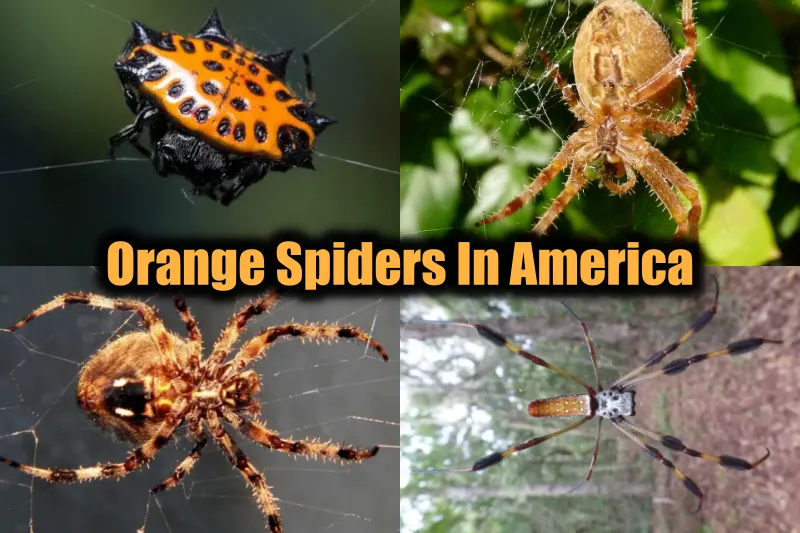Orange spiders are rare due to their color, so it is not every day we encounter a bright orange spider running across our roof.
However, uncommonly, there are species with a slight tinge of orange hue running down their body.
The marbled orb weaver is one of the only completely orange spiders native to the United States. Known for their spherical and globular orange heads and bodies, they can be considered rather cute for their size and color.
Today, we bring forth a concise list of 15 beautiful and remarkable orange spiders native to the United States of America.
And for all the people who love going that extra mile for information, we also have a list of spiders native to Florida!
15 Orange Spiders Native to the America
1) European Garden Spider
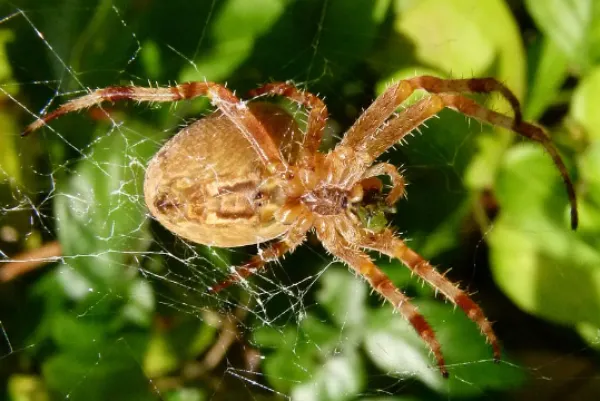
| Scientific Name | Araneus diadematus |
| Size | 5.5-20 mm |
| Identification | Brownish-orange with white markings on their abdomen |
| Geographic location | California, Texas, and Florida |
Some individuals exhibit an orange-brown color variant.
This orange hue can make these spiders particularly eye-catching when spotted in gardens or natural habitats.
They have mottled white markings on the dorsal abdomen. These markings form a distinctive cross pattern, making them easily identifiable among spider species.
Adult females vary in size, ranging from 6.5 to 20 mm in length, while males are generally smaller, measuring between 5.5 to 13 mm.
Like many other spiders, they display cannibalistic behavior, especially during or after sexual activity.
2) Spiny-backed orb-weavers
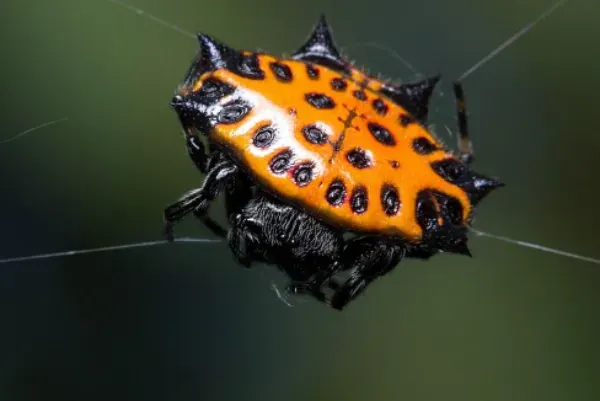
| Scientific Name | Gasteracantha cancriformis |
| Size | 5-13 mm |
| Identification | White/orange upper side with red/black spikes |
| Geographic location | Texas and New Mexico |
The upper side of the abdomen can be either white or yellow/orange, with both color variants species featuring black spots.
They feature six spine-like projections on the abdomen, giving them yet another stand-out look.
Females are larger, measuring 5–9 mm in length, while males are much smaller, ranging from 2 to 3 mm in length.
They have a relatively short lifespan, with individuals living only until they reproduce.
After producing an egg mass, females die, and males also have a limited lifespan, mostly surviving for six days after completing the sperm transfer to the female.
3) Tropical orb-weaver
| Scientific Name | Eriophora ravilla |
| Size | 9-24 mm |
| Identification | Reddish brown legs with white anterior and posterior sides. |
| Geographic location | North and South Carolina and Florida |
They exhibit a range of color variations, with individuals varying from nearly white to nearly black. The females typically have a mostly reddish-brown cephalothorax and legs, with darker femora.
Typically found in open woodlands, including areas with live oak and hammocks. They are known for constructing large orb webs, which sometimes span over 1 meter across.
The bridge thread supporting the web can be exceptionally long, reaching up to 6 meters.
Individuals in Florida and more tropical regions display extensive color and pattern variation.
4) Golden silk orb-weaver
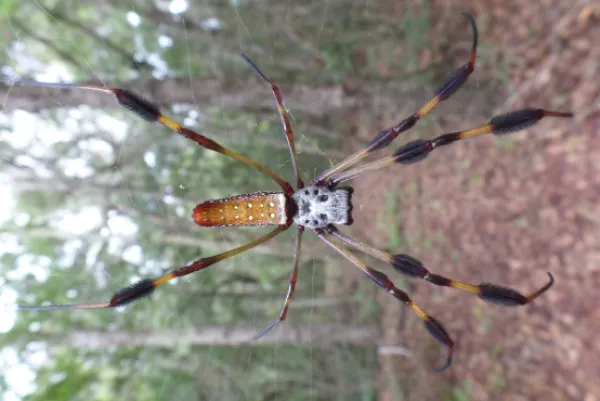
| Scientific Name | Trichonephila clavipes |
| Size | 24-40 mm |
| Identification | Displays sexual dimorphism in both size and color pattern. |
| Geographic location | Oregon, Utah, and Arizona |
They have a striking orange-brown abdomen with two rows of small white-yellow spots. This unique color pattern makes the species relatively easy to identify, particularly females.
Not known to be aggressive towards humans and typically only bites in self-defense if handled roughly.
Females are among the largest non-tarantula spiders in North America, ranging from 24 mm to 40 mm in length when fully developed, while males are much smaller, measuring approximately 6 mm in length, with a simpler dark brown coloration.
Not extremely toxic to humans but pose little health concern to heal thy human adults and are better at controlling the insect population.
5) Spotted orb-weaver
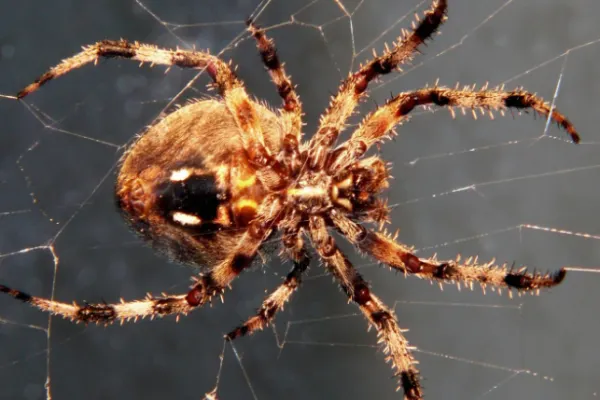
| Scientific Name | Neoscona crucifera |
| Size | 9.5-19 mm |
| Identification | Hairy abdomen with light and dark brown hair sometimes appearing as orange. |
| Geographic location | Kansas, Indiana, and Louisiana |
They show varied coloration throughout their body, the most observed coloration is a rusty-red or golden-orange body.
They often build their webs on buildings and other man-made structures, several feet above ground level.
Generally, a nocturnal species, they tend to hide in a curled leaf near the edge of their web during the day.
When provoked, they tend to bite but their venom poses no harm to humans.
The females lay their eggs in a sac made of their silk, which is hung near their web until the baby spiders hatch.
6) Pennsylvania Funnel-Web Spider
| Scientific Name | Agelenopsis pennsylvanica |
| Size | 7-14 mm |
| Identification | Solitary spider with funnel-shaped web |
| Geographic location | Washington, California, and Texas |
They are not purely orange, but rather an amalgamation of darker and milder tones to help them get a better chance at survival!
They have dark markings on the carapace, along with yellow-orange and black patterns on the sternum and abdomen and a large V-shaped mark.
They are known for their unique web-building behavior.
They construct funnel-shaped webs typically located on the ground or in vegetation, hence their name.
They have a very intriguing yet not uncommon mating pattern where the females feed on the males.
These cannibalistic tendencies have proven to result in better-quality eggs.
7) Woodlouse spider
| Scientific Name | Dysdera crocata |
| Size | 9-15 mm |
| Identification | Shiny beige-yellow abdomen, usually found in warm places |
| Geographic location | Chicago, Miami, and Houston |
Their abdomen is typically pale beige to yellow-brown, sometimes appearing dark grey with dark-red or tawny orange cephalothorax and legs.
They get their common name from the fact that they prey on woodlouse.
Though their prey has a tough exoskeleton, woodlouse spiders have large chelicerae that allow them to pierce the wood lice’s soft underbelly easily.
Their unique coloration has proved to be beneficial in terms of blending well with their habitat.
8) Arrowhead Orb-weaver
| Scientific Name | Verrucosa arenata |
| Size | 4-14 mm |
| Identification | While females have a characteristic triangle on their abdomen while it is absent in males |
| Geographic location | Nebraska and Texas |
The abdomen color of this spider species can range from white to yellow/orange.
Orangish-yellow arrowhead spiders are more visible to prey and attract more prey, while white spiders, less visible, are dominant and have better living conditions.
Unlike most orb-weavers, who have globular abdomens Arrowhead orb-weavers have a very distinct triangular abdomen.
Another noticeable feature is their ability to construct an ‘invisible web’ which lacks radial threads.
They show sexual dimorphism, where the females have a prominent triangular abdomen while the males lack one.
9) Broad-Faced Sac Spider
| Scientific Name | Trachelas tranquillus |
| Size | 5-10 mm |
| Identification | Pale yellow abdomen with faint stripes on the dorsal side. |
| Geographic location | Iowa, North, and South Dakota, and Minnesota |
They are not typically orange but the color of their abdomen can range from yellow to gray, thereby sometimes featuring an orange hue.
They have varied habitat preferences, sometimes found outdoors on foliage, other times under leaf litter, stones, and boards, and sometimes on buildings under windowsills and siding.
These spiders can deliver a painful bite, like a bite from a wasp or a bee.
There have been reported cases of secondary infection associated with their bite.
10) Bowl and Doily Spider
| Scientific Name | Frontinella pyramitela |
| Size | 4 mm |
| Identification | Their webs are in the shape of a dome |
| Geographic location | Kansas, Missouri, Iowa, and Minnesota |
They are typically reddish-brown in color with more yellowish legs.
Under sunlight, the reddish-brown hue appears as a darker shade of orange.
Another distinct feature is their ability to construct an intricate sheet web consisting of an inverted dome-shaped web (the “bowl”) suspended on top of a horizontal sheet web (the “doily”).
Unlike many solitary spiders, these spiders tend to stay together.
Males from this species may stay with a female for extended periods beyond copulation.
They use sun rays to deplete their metabolic activity in order to focus more on reproduction.
11) Marbled Orb-weaver
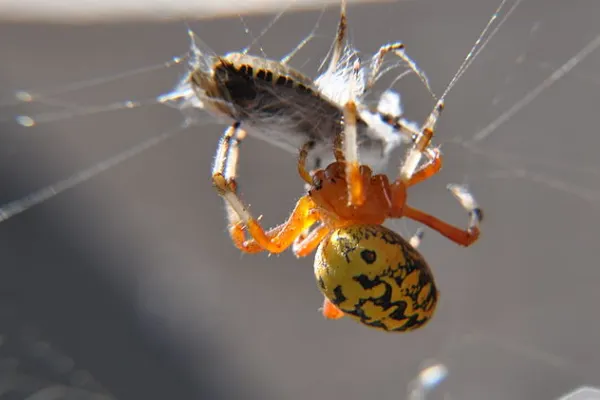
| Scientific Name | Araneus marmoreus |
| Size | 9-20 mm |
| Identification | Females have an inflated abdomen resembling a pumpkin |
| Geographic location | Washinton, Montana, North Dakota and Minnesota |
Sometimes referred to as the “pumpkin spider” due to the resemblance of the female’s inflated abdomen to an orange pumpkin.
They exhibit a wide array of colorations and patterns. The most common color morph of them is an orange abdomen with brown to black markings.
They construct their orb-shaped web in places like trees, shrubs, tall weeds, and grasses in moist, wooded environments.
Their webs are equipped with a ‘signal’ thread to alert them of any prey.
12) Mabel Orchard Orb-weaver
| Scientific Name | Leucauge argyrobapta |
| Size | 3.5-7.5 mm |
| Identification | Long-jawed species of orb-weavers |
| Geographic location | Texas, New Mexico, Arizona, and Louisiana |
One of the most common and beautiful species in eastern USA.
They have abdomens that feature dark mid-dorsal and reddish-orange triangular ventral areas and dorsolateral spots, creating an eye-catching coloration pattern.
They have a silvery-white appearance due to the presence of thin, platelet-like guanine crystals that reflect light.
They act as natural pest control, especially against mosquitoes and other disease-causing pests.
13) Long-palped ant-mimicking spider
| Scientific Name | Castianeira longipalpa |
| Size | ~6.9 mm |
| Identification | Their body resembles that of an ant. |
| Geographic location | Washinton, Montana, North Dakota and Minnesota |
Besides having the same color, orange as the common ants, they have developed a fake thread waist creating an illusion of a third body segment while there are only two present.
They also can mimic the smell of ants by rubbing the formic acids secreted by ants against their body.
By mimicking the ants, they escape their common predators like wasps and birds that usually avoid ants.
14) Brilliant Jumping Spider
| Scientific Name | Phidippus clarus |
| Size | 3-4 mm |
| Identification | Distinct rectangular dorsal section |
| Geographic location | Florida, Oklahoma, Utah, and Nevada |
While their coloration can vary from red/brown to lighter yellow or brown, the presence of orange hues with darker markings is what makes them stand out.
They prey on insects, other spiders, and various terrestrial arthropods.
Females produce well over 100 eggs per sac, with an average clutch containing approximately 135 eggs.
15) Black-Tailed Red Sheetweaver
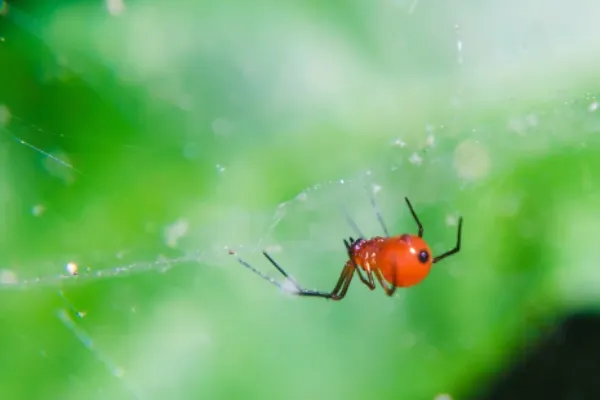
| Scientific Name | Florinda coccinea |
| Size | 3-4 mm |
| Identification | Distinct rectangular dorsal section |
| Geographic location | Montana, North Dakota, Nebraska and Texas |
Black-tailed red Sheetweavers have vibrant reddish-orange bodies with distinctive black caudal tubercles.
They are known to construct distinctive webs that consist of a horizontal sheet made of non-sticky silk.
This web structure aids in capturing insects with ease.
There are around 55 species of spiders found in Florida:
Argiope argentata (Silver Garden Spider)
Argiope aurantia (Black and Yellow Garden Spider)
Argiope trifasciata (Banded Garden Spider)
Castianeira descripta (Red-spotted Ant-mimic)
Cithaeron praedonius
Colonus sylvanus (Sylvana Jumping Spider)
Eriophora ravilla (Tropical Orb-weaver)
Gasteracantha cancriformis (Spiny-backed Orb-weaver)
Gea heptagon (Heptagonal Orb-weaver)
Hamataliwa grisea
Hentzia palmarum (Hentz Jumping Spider)
Hibana velox
Hogna lenta
Latrodectus geometricus (Brown Widow Spider)
Latrodectus mactans (Southern Black Widow)
Leucauge argyra
Leucauge argyrobapta (Mabel Orchard Orb-weaver)
Leucauge licina (Dominican Spider)
Lyssomanes viridis (Magnolia Green Jumper)
Metaltella simoni (Hacklemesh Weaver)
Metazygia zilloides
Neoscona arabesca (Arabesque Orb-weaver)
Neoscona domiciliorum (Spotted Orb-weaver)
Nesticodes rufipes (Red House Spider)
Phidippus regius (Regal Jumping Spider)
Philodromus floridensis
Pisaurina brevipes
Pisaurina mira (Nursery Web Spider)
Steatoda triangulosa (Triangulate Cobweb Spider)
Trebacosa marxi
Trichonephila clavipes (Golden Silk Orb-weaver)
Conclusion:
With this, we’ve come to the end of yet another article deciphering layer by layer the creation of nature. Tune in to know more about the earth you inhabit.
Also Read:

Hi everyone, my name is Shawna, and I’ve always been fascinated by the fascinating diversity of flora and fauna that our nature has in it. I am currently studying biotechnology and am particularly interested in animal biotechnology, delving into the intricate processes that define their true nature and uniqueness.
